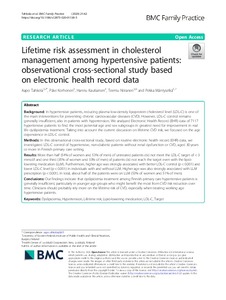Lifetime risk assessment in cholesterol management among hypertensive patients: observational cross-sectional study based on electronic health record data
Aapo Tahkola; Päivi Korhonen; Hannu Kautiainen; Teemu Niiranen; Pekka Mäntyselkä
Lifetime risk assessment in cholesterol management among hypertensive patients: observational cross-sectional study based on electronic health record data
Aapo Tahkola
Päivi Korhonen
Hannu Kautiainen
Teemu Niiranen
Pekka Mäntyselkä
BMC
Julkaisun pysyvä osoite on:
https://urn.fi/URN:NBN:fi-fe2021042822169
https://urn.fi/URN:NBN:fi-fe2021042822169
Tiivistelmä
Background: In hypertensive patients, reducing plasma low-density lipoprotein cholesterol level (LDL-C) is one of the main interventions for preventing chronic cardiovascular diseases (CVD). However, LDL-C control remains generally insufficient, also in patients with hypertension. We analyzed Electronic Health Record (EHR) data of 7117 hypertensive patients to find the most potential age and sex subgroups in greatest need for improvement in real life dyslipidemia treatment. Taking into account the current discussion on lifetime CVD risk, we focused on the age dependence in LDL-C control.
Methods: In this observational cross-sectional study, based on routine electronic health record (EHR) data, we investigated LDL-C control of hypertensive, non-diabetic patients without renal dysfunction or CVD, aged 30 years or more in Finnish primary care setting.
Results: More than half (54% of women and 53% of men) of untreated patients did not meet the LDL-C target of < 3 mmol/l and one third (35% of women and 33% of men) of patients did not reach the target even with the lipid-lowering medication (LLM). Furthermore, higher age was strongly associated with better LDL-C control (p < 0.001) and lower LDL-C level (p < 0.001) in individuals with and without LLM. Higher age was also strongly associated with LLM prescription (p < 0.001). In total, about half of the patients were on LLM (53% of women and 51% of men).
Conclusions: Our findings indicate that dyslipidemia treatment among Finnish primary care hypertensive patients is generally insufficient, particularly in younger age groups who might benefit the most from CVD risk reduction over time. Clinicians should probably rely more on the lifetime risk of CVD, especially when treating working age hypertensive patients.
Kokoelmat
- Rinnakkaistallenteet [27094]
